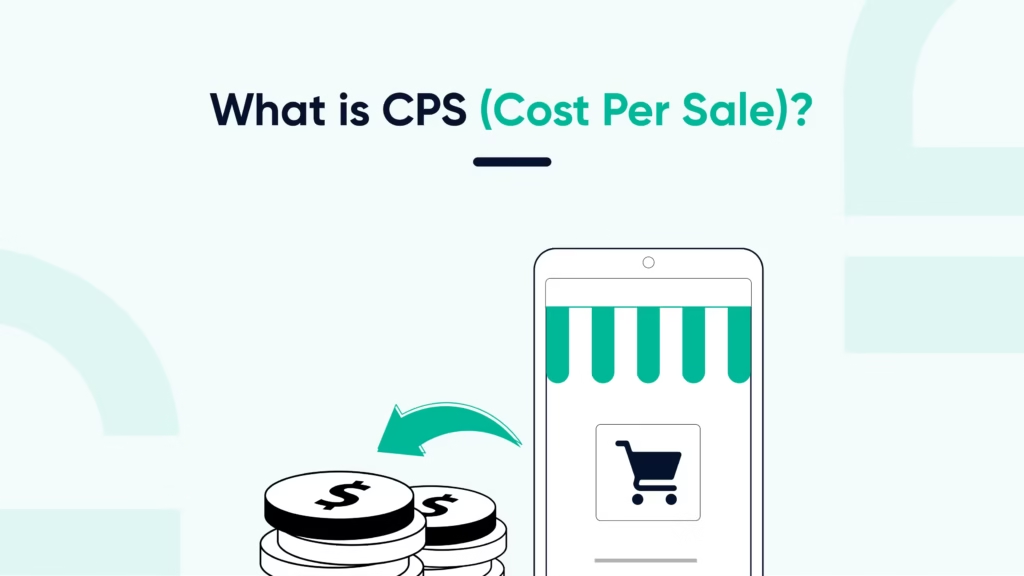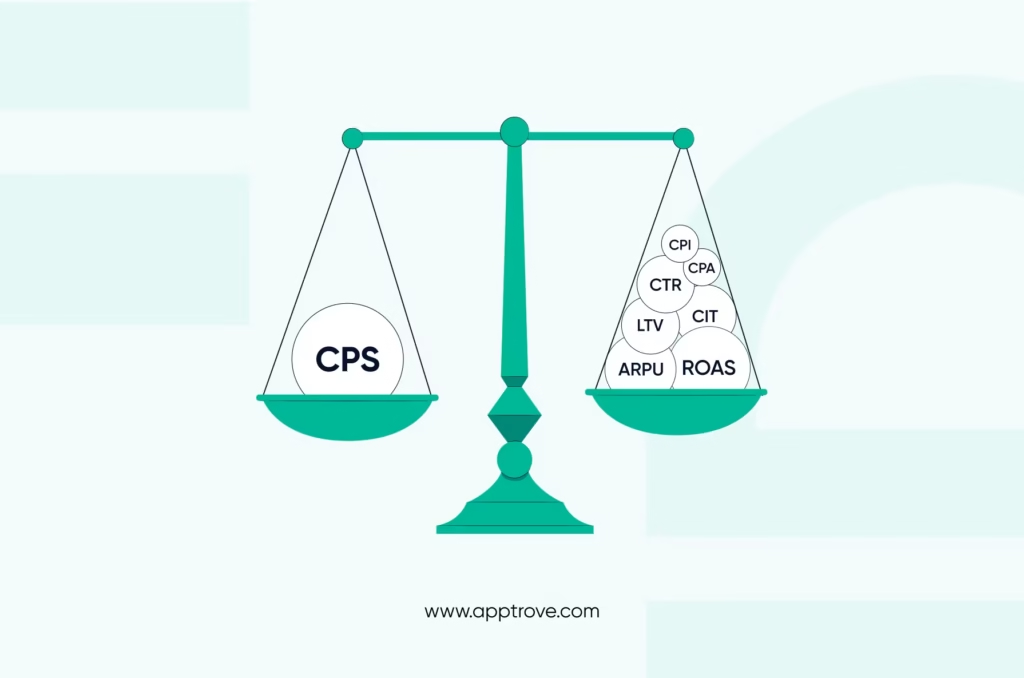
What is CPS (Cost Per Sale)?
CPS or Cost Per Sale is a marketing term that is primarily used to measure the used amount to generate a sale through an ad campaign. For a quick overview, it can be calculated with the help of the total amount spent in an ad campaign and the total number of sales generated from the campaign.
This term can be used to understand the impact of your ad and marketing campaigns on generating revenue. In other words, CPS gives a straightforward look at how well your marketing campaigns performed where your main motto is to generate sales through them.
How to Calculate CPS?
The favourable part is that determining CPS is very simple. All you need are two numbers.
- The total amount you have spent on advertising or marketing.
- The total number of sales that were made from that advertising.
Here is the formula:
- Cost Per Sale = Total Ad Spend ÷ Total Sales

Example:
Let’s say you spent $1000 on ads and had 20 sales.
CPS= $1000 ÷ 20= $50
So your CPS is $50.

If you make $100 from each sale, then spending $20 to get that sale is a good deal. But, if your product only makes you $15 per sale, then your CPS is too high.
Knowing how to calculate Cost Per Sale helps you decide whether to carry on with your ads, stop, or improve your ads.
Prominent Advantages of CPS as a Criterion
Cost per Sale is a vital metric that connects your marketing investment to actual sales. The major differentiator is that impressions and clicks are metrics of awareness, while this metric focuses on outcomes, ultimately making it easier to assess whether you made the right marketing investment.
Efficient that Drives Outcomes
Now you can only spend money when a sale occurs; therefore, you can say goodbye to wasted ad spend and maximize your ROAS. This performance-based model allows businesses to lower their costs, grow their sales, or even find the goldilocks option.
Better Targeting and Personalization
Cost per Sale directs marketing teams to be better, smarter and understating Targeting is improved when the focus is on CPS. Getting better at identifying users that actually might buy your product means more efficient campaigns. Using data and behavioral insights helps marketers segment audiences better and serve ads that are most appropriate to their interests and needs.
Personalized User Experiences
When campaigns are built around user’s behavior and interests, ads seem relevant. Take a music or fitness app for example, the app will likely focus on different features depending on users, and generates more engagement, conversion, and loyal customers.
Improved ROI and Smarter Budgets
Cost per Sale allows for clearer tracking of ROI. Since every dollar spent corresponds to revenue, measuring profitability is straightforward. You can compare CPS across different campaigns or channels and find your best performance for future budget allocation.
Data-Driven Optimization
CPS allows for better optimization. Constantly tracking results allows marketers to be forward-looking in testing new creatives, messaging, and target audiences in order to reduce costs and increase results over the long run.
Team Alignment and Accountability
One last thing – Cost per Sale aligns sales and marketing teams with a single outcome in mind, closing deals. Everyone is working toward measurable and impactful performance, beyond just traffic or clicks.
A Comparison Between CPS and Other Metrics
CPS gives you an overview that whether your ad campaign are fulfilling your targets and performing as per your expectations or not. Undoubtedly, it is one of the crucial metrics to measure. But, any of the marketers should not rely on this metric solely.
A clear and loud comparison of CPS and others metrics will give you an idea about which metric to measure in different usecases. So, let’s just get into the details.
- CPS vs CPC:
CPC (cost per click) simply defines the cost to get a click on your ad.
While CPS only defines the cost of getting a sale through your ad campaign. On the other hand, CPC only defines the cost of getting a click on your ad whether the click leads to a sale or not. Cost per sale is directly relevant to your ad spend and revenue, while CPC is all about generating traffic for your app or website.
- CPS vs CPM:
Marketers use CPM or cost per mile to measure the cost of each thousand impressions of your ad.
CPM is the metric that is used for brand awareness campaigns or brands, who are in their initial stage. But, CPS only focuses on getting a sale and stands as the final step in a conversion funnel.

- CPS vs CPL:
CPL stands for cost per lead. It indicates to the cost to acquire a lead.
The cost of obtaining a potential or interested customer’s contact information during an advertising campaign is referred to as CPL. Consequently, CPL comes in handy for campaigns aimed at generating interest or capturing contact info, and CPS serves as the final step in the conversion funnel.
- CPS vs LTV:
LTV or lifetime value is the total amount of revenue that any of the users generate during their whole relationship period with a business.
While CPS stands for the cost of acquiring a sale, LTV shows the lifetime journey of that customer. When a lower CPS is combined with a high LTV, it can be more meaningful and beneficial for a business.
How CPS Works with Other Metrics in Attribution Models?
CPS and Attribution Models
CPS can differ from what is attributable from the sale.
- First-touch attribution: Awards the first ad they engaged with, which will provide value if you target the top of funnel strategies
- Last-touch attribution: Awards the last ad they clicked before making the purchase, tends to favour the low-funnel channels
- Multi-touch attribution: My personal favourite. Awards credit across all ad touchpoints so you can have a full consideration.
It is important to understand attribution models so you can assess CPS properly and allocate budgets appropriately across your funnel.
To Wrap it Up
Cost per Sale (CPS) is a valuable marketing metric representing how much you have spent to get a sale (through advertising). Since CPS is a measure of actual sales, rather than clicks or impressions, CPS provides useful insights into how well ads work through a relationship between the advertising expenditure and revenue. Moreover, CPS is easy to calculate, which makes it very helpful to compare annual, monthly, and weekly budgets, targeting, and assessments of campaign effectiveness.
The value of being able to measure CPS can range from improved return on investment, increased personalization of audience targeting to stronger alignment between your sales and marketing professionals.
FAQs
What is cost per sale?
CPS stands for the cost to acquiring a sale through an ad campaign. This can be calculated with the help of the total amount spent in an ad campaign and the total number of sales generated from the campaign.
How do i divide total marketing costs per sales?
For this, you need to divide the total expense of your marketing efforts by the total sales’ revenue. Additionally, you can multiply the outcome by 100 to get the exact percentage.
What are the possible factors that impact your CPS?
Here are some of the most prominent factors that leave o\an impact on your CPS:
- The audience you’re targeting
- The region where you want your ads to show
- Undoubtedly your sales process
- Spending on customer services.